Yoshimura history – 22
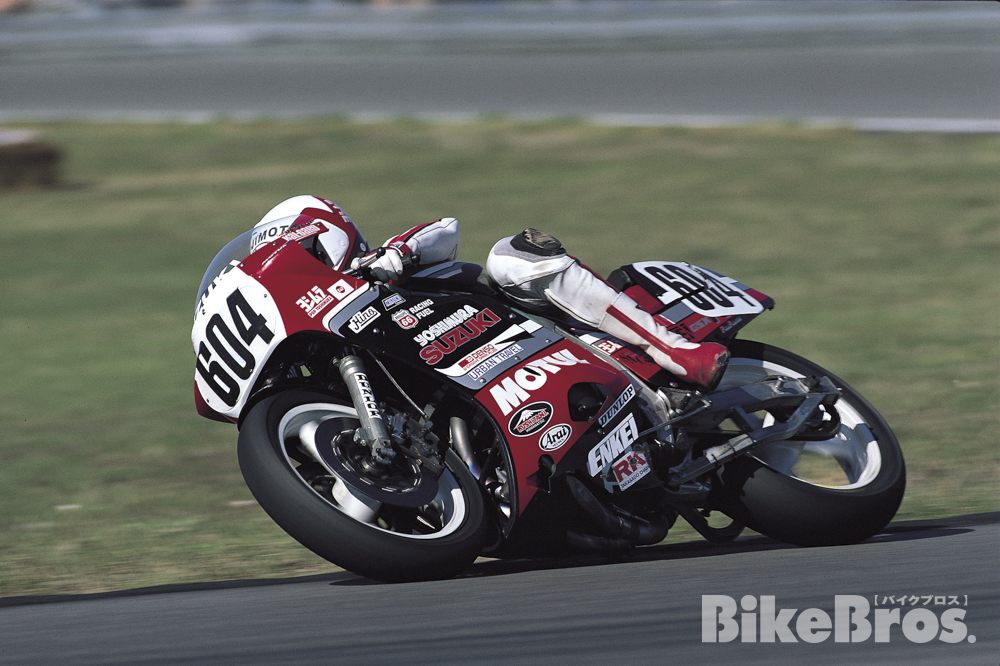
#604 Tsujimoto going through the Daytona infield. The AMA Superbike-spec GSX-R750 was his favorite since, although it was heavier than the Formula TT-F1 version, it was substantially more powerful. The AMA allowed the use of 1mm oversize pistons, so the Superbike version’s displacement was enlarged to 771.25cc with a bore and stroke of φ71 x 48.7mm, while the TT-F1 engine was bored 1% oversized 756.12cc with φ70.3 x 48.7 mm (the stock is 749.68cc with φ70 x 48.7 mm).
Yoshimura History #22: The Two Young Challengers
1986 Daytona, Part Two
The 1986 Daytona 200 miraculously brought together champions and promising young riders. In this race Team Yoshimura Suzuki entered the new oil-cooled GSX-R750 for its AMA debut, piloted by 1985 All-Japan TT-F1 champion Satoshi Tsujimoto and Kevin Schwantz. The team also introduced their innovative Duplex Cyclone exhaust technology in the United States for the first time.
Yamaha brought in the 1981-1982 AMA Superbike Champion and the 1984 GP500 World Champion Eddie Lawson just for this one race, while their AMA regulars were 1985 US Formula One Champion Mike Baldwin and Kenny Roberts’ disciple, 1981 AMA Flat Track Rookie of the Year Jimmy Filice. Yamaha also gave 17-year-old rookie John Kocinski –––– who could not enter the Daytona 200 (March 9th) because it was before his birthday (March 20th) –––– an FZ750 to race in the AMA/CCS race held the week before. That is how much Yamaha wanted the FZ750 to win in its second year of AMA competition. And unlike the previous year, the 1986 FZ750 (OU45) was factory built by Yamaha Motor headquarter in Japan.
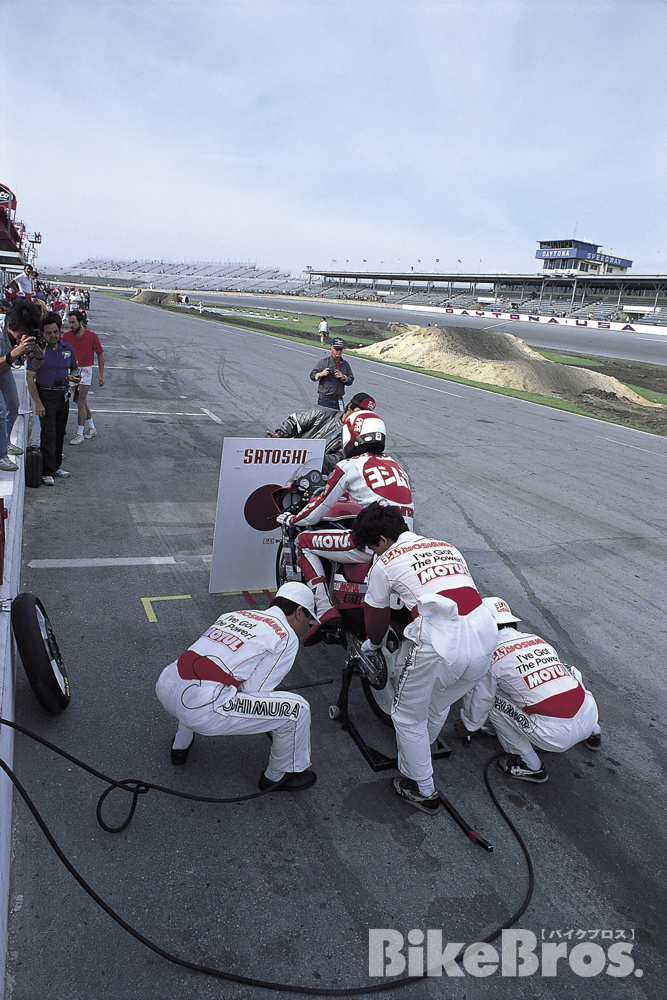
#604 Tsujimoto had the Hinomaru (Japanese national flag) design on both his suits and his pitstop board. The team staff also wore white uniforms, giving the team a sense of noble grace. With the GSX-R750, a machine that can win, the team had an atmosphere similar to that of the GS750/1000 era, as they were “highly motivated to do it again!” as Suehiro Watanabe (Yoshimura R&D) recalls.
For American Honda, like Suzuki, the 1986 Daytona 200 was the debut of the up-to-the-minute VFR750F (2nd generation V4) and their team boasted a strong lineup including the 1983 AMA Superbike Champion Wayne Rainey and the 1984-1985 AMA Superbike Champion Fred Merkel. The original lineup was a three-rider team that also included Freddie Spencer, but Spencer was sidelined with an ear infection (which made Tsujimoto really disappointed).
There were even more champions at the event, including the 1978-1979 GP250 & GP350 World Champion Kork Ballington on Suzuki Great Britain’s Skoal Bandit GSX-R750 and a total of three AMA Grand National Champion flat-trackers: 1985 Champ Bubba Shobert on American Honda VF750F (previous year’s factory machine), 1976-1977-1978 Champ Jay Springsteen on Super Team Yamaha FZ750, and the 1982 and 1984 Champ Ricky Graham on another Super Team Yamaha FZ750.
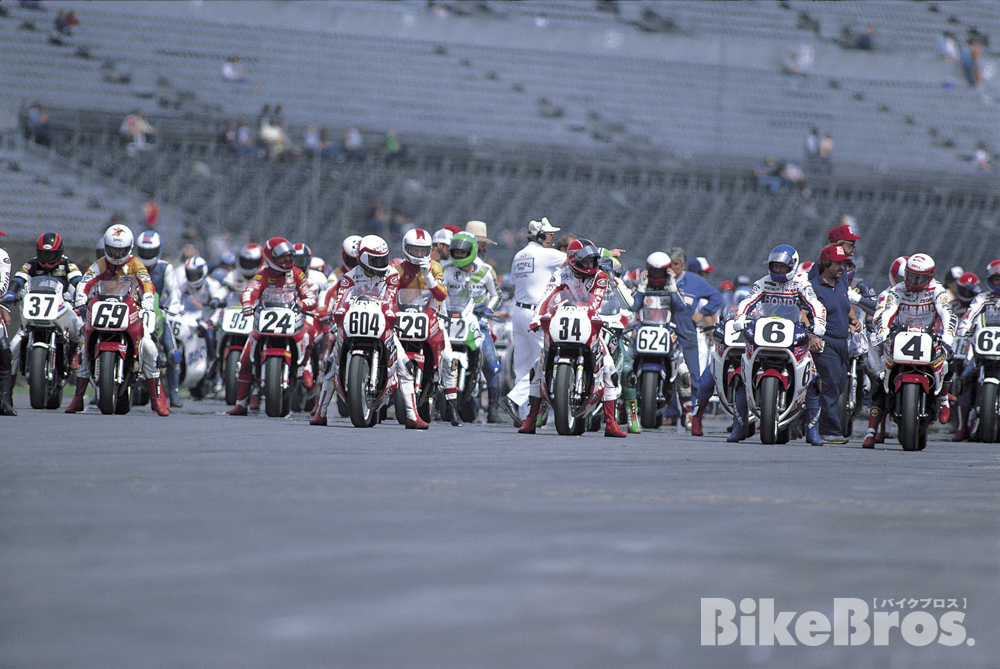
At Daytona, the race starts from the wide pit road. Pole position went to #4 Lawson, with #6 Rainey second, #34 Schwantz third, and #604 Tsujimoto fourth. The flat-trackers #67 Shobert at far right, and #129 Springsteen behind Tsujimoto. Tsujimoto was amazed by the left-hand oval-track riders as he recalls, “Springsteen was incredibly fast on left turns, but was like an amateur on right turns, which was quite interesting.”
The starting grid positions for the Daytona 200-mile race is determined by a unique qualifying system. First, the top five (front row) are determined by Timed Practice. The entrants are then divided into two groups, each of which goes out for a 50-mile, 15-lap heat race, and the results will determine the starting grid for the 6th position and below. The 200-mile, 57-lap final race features a total of 80 entrants (with some failing to qualify).
As a result of the Timed Practice for 1986 Daytona 200, the pole position went to active GP500 rider Eddie Lawson (1:56.228), followed by Wayne Rainey (1:56.423) in 2nd and Kevin Schwantz (1:57.429) in 3rd. Tsujimoto was 4th with a brilliant 1:59.032, followed by Mike Baldwin in 5th with a 1:59.034.
During the Timed Practice, and throughout the practice sessions, a photoelectric speed trap was informally set at the finish line –––– on the 18-degree banking in front of the grandstands –––– to measure top speed. Although that location may not always be the best spot to measure the maximum speed, the record showed that the fastest rider was Rainey on VFR750F at 171.42 mph (about 275.58 kph), followed closely by Lawson on FZ750 at 170.13 mph (about 273.74 kph) and then by Schwantz on GSX-R750 at 169.17 mph (about 272.19 kph). The fact that Lawson’s FZ750 was the only one of the three bikes that was not fully faired proved just how good his riding skills were.
As for power, it was American Honda VFR750F that dominated the rest of the field in the super-fast sections from the west 31-degree banking, through the backstretch, the east 31-degree turn 4, the bottom straight and to the 18-degree banking in front of the grandstands. Still, Lawson consistently beats others in lap times and is almost always the fastest. For example, the section prior to the west 31-degree high bank runs from the flat infield, through the concrete apron (outside of the asphalt main course) and then it rises sharply and suddenly. Both Rainey and Schwantz open wide on the flat section and then get into a massive power-slide in conjunction with counter-steering to climb up the banking, trying to enter the line right next to the outer wall. In contrast, Lawson accelerates smoothly by opening the throttle modestly as he lifts his torso up to absorb the shock of the transition between the infield and the banking,and climbs up the banking swiftly as if there was no transition.
Tsujimoto recalls, “Eddie overtook me on the bank without crouching. He was sitting straight up. It was humiliating…. No one could ride that smooth. It was hard to believe we were riding on the same track.”
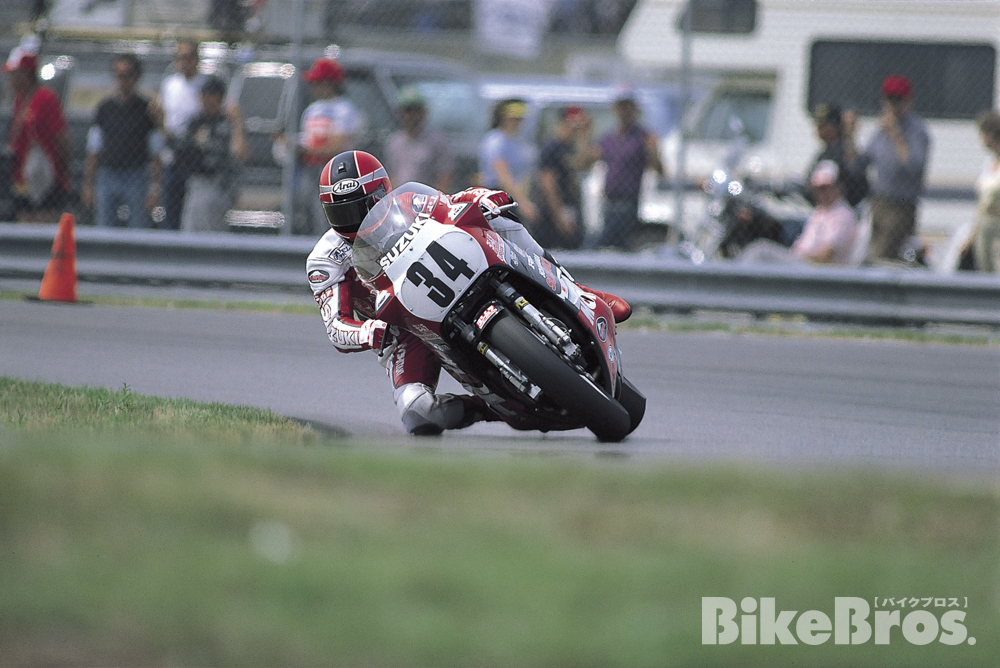
Kevin Schwantz has been wearing #34 since the 1986 season. Here, he is just sliding his butt sideways, still far from his typical lean-out riding form. He finished 2nd in the final, but he was not satisfied with his performance. He also had a problem with his left handlebar grip which, although safety-wired at three points, became loose during the race. He pulled the grip off and showed it to others after the finish.
In the heat races, the 1st heat (of 59 bikes) was won by Lawson, followed by Filice in 2nd and Ballington in 3rd. The 2nd heat (of 60 bikes) was won by Rainey, followed by Merkel in 2nd and Tsujimoto in 3rd. 80 riders made it to the final and about half of the entrants end up participating only in a heat race, but still, it’s a great 50-mile race and the whole event is considered to satisfy even those who fail to qualify. In fact, what’s great about American racing events are that they are all about the entrants having the most fun.
Tsujimoto once asked Schwantz about his strategy for Daytona. “Kevin’s answer was simply, WIDE. OPEN.”
Daytona is a test of courage and technique. Whether on the bank or in the infield, it all begins with opening the throttle. Then comes technique. Tsujimoto has the courage to twist the throttle wide open. He is not afraid of the bank or the wall. He can also power slide. Of course, so can Schwantz and Rainey. However, only Lawson has a far superior technique that makes a bike run more swiftly. But Tsujimoto and the rest of the young riders are, at that time, confident that their courage and passion are second to none, and they have been boldly challenging the world champions.
The start of the Daytona 200 is unique. It is held on a long, wide pit road that bypasses the portion of the outer tri-oval course in front of the grandstand. This is because this section is banked, making a standing start impossible (the 18-degree angle is so steep that one can barely stand). The 80 entrants in the final are divided into two groups, the first wave and the second wave, and they start at different times. The second wave is delayed by the starting flag, but this is not a problem for them, as their goal is to finish the race.
The 45th Daytona 200 got underway with Lawson leading smoothly from pole position. He was followed by Rainey and Schwantz. Tsujimoto was a little behind them, as he was still getting used to AMA’s starting rules. As in All-Japan TT-F1, the engine is started before the race starts, but the bike does not have to remain stationary and is allowed to proceed to the grid line. If this were done in any other race (including All-Japan events), it would definitely be a false start. Although Tsujimoto made a better start than in 50-mile heat race, he fell behind Rainey and other AMA regulars at the start.
Lawson, Rainey and Schwantz were the top three. After six laps, Rainey took the lead, but Lawson saved his tires and matched the pace of his rivals. Lawson was so calm that it was almost as if he was intentionally giving up the lead. Schwantz, on the other hand, felt that he was going “too fast” in this battle. He was trying to keep his pace and was gradually pulling away from the pair.
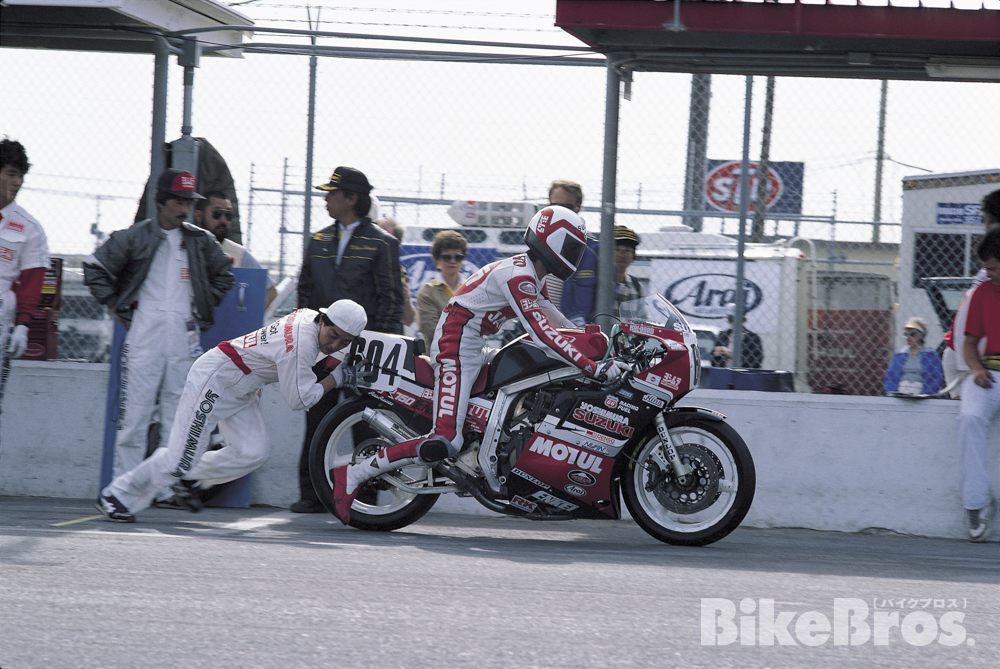
#604 Tsujimoto took a bit of time at the pit stop, which opened up the distance between him and Schwantz in 2nd place. Tire changes in Daytona 200 are basically for the rear wheels only. Both front and rear tires are super high-speed Daytona specials, which are inflated with extremely high air pressure around 3kg/cm² instead of the typical 2kg/cm² range. According to Tsujimoto, the tires are “as hard as stones and they slide easily.” The GSX-R750 has 17-inch tires front and rear, while FZ and VFR have 17-inch front and 18-inch rear (all bias-ply).
The formation of the leading group suddenly changed on Lap 15, when Rainey began to slow down. He came into the pit earlier than scheduled for a fresh rear tire. However, the pit was not ready for the tire change, resulting in a time loss of about 50 seconds. The cause was a chunking or blistering (a bubble or burst in the tread due to overheating) in the tire. The softer compound was obviously the wrong choice. After 18 laps, Lawson made a 13-second pit stop for gas. At the same lap, Schwantz also came into the pit.
“Satoshi Tsujimoto takes the lead!” A booth announcer shouted.
Tsujimoto had stayed out without pitting, so he was automatically in the lead, but the announcer did not miss it. Tsujimoto had already appeared on radio programs and in on-the-spot interviews, attracting attention and popularity as kamikaze boy Satoshi Tsujimoto. Tsujimoto pitted at the end of Lap 20 and relinquished the lead. 26 laps in, Schwantz was 24 seconds behind the leading Lawson, and was followed by Tsujimoto, Merkel and Baldwin.
Tsujimoto’s challenge ended abruptly on Lap 33 as he entered the chicane at the end of the backstretch. A connecting rod bolt has ruptured after completing 31 laps (32 laps according to Yoshimura’s count). As a matter of fact, the connecting rods included in the GSX-R750 Racing Kit had strength issues (such as the connecting rod bolts stretching) which has previously led to some engine failures. Responding to this problem, Fujio thereafter replaced the connecting rods for the Yoshimura Suzuki GSX-R750 with U.S.-made Carrillo¬’s. Carrillo connecting rods, which were made of nickel-chromium-molybdenum alloy with an “H” cross section, were extremely rigid and well balanced, and were highly regarded for road racing, drag racing and high-performance street applications (including the Yoshimura Tornado 1200 Bonneville which would debut later).
On Lap 37, Lawson as per strategy made a routine pit-stop for refueling and a rear tire change. Schwantz also pitted for gas and a fresh tire, however, his drive chain was accidentally stretched too tight during the tire change, gradually damaging the drive sprocket and causing the chain to jump teeth. By the time the race comes to a close, Schwantz was in no condition to chase Lawson. The 1986 Daytona 200 was thus concluded with Lawson as the winner, Schwantz in 2nd and Merkel in 3rd.
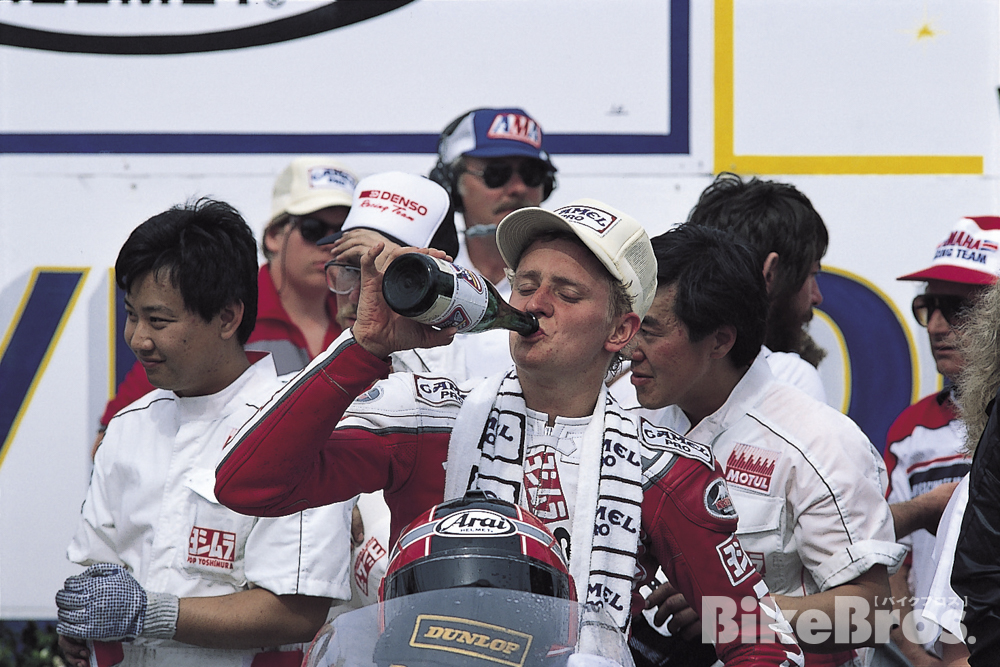
“I just came in second.” Second place in the Daytona 200 is a result that should be celebrated, but for Kevin Schwantz, the victory champagne was bittersweet (he is not a strong drinker and would get drunk on a can of beer). He was completely outclassed by Eddie Lawson and filled with frustration and helplessness on the Victory Lane.
For Tsujimoto, the reality was more frustrating than the retirement from the race. Schwantz and Rainey were his rivals, not his source of inspirations. Lawson’s riding technique, however, left a strong impact on Tsujimoto and gave him a specific objective to pursue. Tsujimoto came to regard Lawson and the GP500 racing, the world in which Lawson lives, as his professional goals. It was not a vague dream, but an actual possibility. From then on, Tsujimoto’s riding style changed drastically. Fujio felt that the Daytona Challenge exceeded his expectations, with Tsujimoto’s growth as a racing rider and GSX-R’s power increase in its second year.
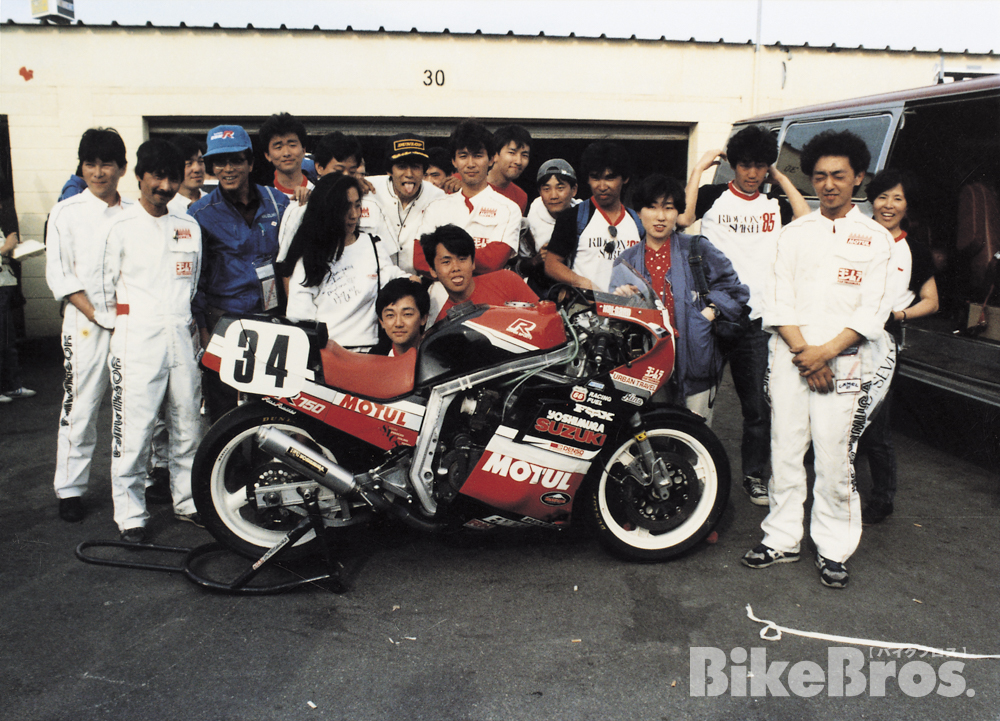
Japanese staff and supporters pose for a commemorative photo in front of the garage at Daytona to celebrate #34 Schwantz’s 2nd place finish. From left in the front row are Tsujimoto’s chief mechanic Kunio Asakawa, Fujio and Suzuki engineer (aka the father of the GSX-R) Etsuo Yokouchi. Tsujimoto is in the center with his tongue sticking out. Next to him on the right is Tsujimoto’s mechanic Osamu Takenaka.
============================================================
Published on December 12, 2022
Stories and photos supplied by Yoshimura Japan / Shigeo Kibiki / Takao Isobe
Written by Tomoya Ishibashi
Edited by Bike Bros Magazines
[ Japanese Page ]
